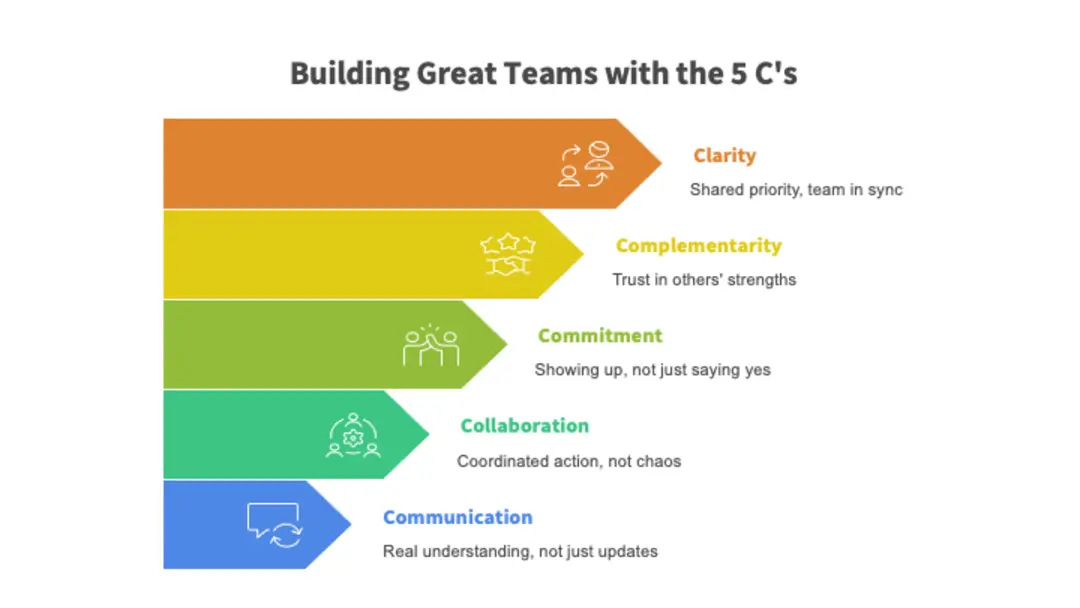Why Smart Teams Fail and How These 5 Simple Ideas Turned Things Around


A few months ago, I met a startup team that had everything going for them.
They had just raised their Series A funding. Their product was strong. The tech team included IIT graduates. Early users were showing interest.
On paper, it looked like a perfect setup.
But when I met their CEO, whom we will call Arjun, something did not feel right. He looked tired and a bit stressed.
He said something that stuck with me.
“We have some of the smartest people I have ever worked with. But we are not moving fast. People are working hard, but not together.”
That last part, “not together,” became the starting point of something important.
Let me take you through their story and how they discovered what was missing. We ended up calling it The 5 C’s of Team Building. These five things helped them go from a group of talented individuals to a real team.

Here is how each one showed up in real life.
1. Communication: Talking Is Not the Same as Understanding
During a product release, the design team thought they were working on one version of the app. The tech team had something else in mind. Marketing was preparing a campaign for a version that did not even exist.
Everyone was sharing updates. But no one was really stopping to understand each other.
Messages were sent. Emails were written. Meetings were held. But the intent behind those messages was getting lost.
We did not bring in a new tool or software. Instead, we simply asked one question.
“What if we just spent ten minutes a week clearing up assumptions?”
That one small change led to a weekly alignment meeting. In these meetings, people did not just say what they were working on. They clarified what was expected and why it mattered.
After a month, mistakes reduced. Teams started understanding each other better. People were finishing each other’s thoughts instead of questioning each other’s decisions.
The difference came not from working more, but from communicating better.
2. Collaboration: When Everyone Tries to Help, No One Listens
During a strategy meeting, Arjun said, “Everyone here is smart, but it feels like we are stepping on each other’s toes.”
One of the engineers laughed and replied, “It is like we all want to help, but no one listens first.”
It was not a lack of effort. Everyone wanted to contribute. But too many people were jumping in without a clear plan.
As a result, roles got blurred. Work was being repeated. People felt confused and sometimes even unappreciated.
So we did something simple. We clearly mapped out roles for the next project.
Not just job titles, but real roles. Who decides. Who contributes. Who approves. Who should just be kept informed.
Within days, the confusion reduced. People knew where to step in and where to step back.
True collaboration is not about everyone doing everything. It is about the right people doing the right things at the right time.
3. Commitment: Saying Yes Is Not the Same as Showing Up
One day during a town hall, a mid-level manager asked, “Why do we even set OKRs? They do not change how we work.”
That was a warning sign.
People were attending meetings. Nodding in agreement. But after the meeting, they would go back to doing what they personally thought was important.
There was a pattern. People were not committing to results. They were committing to effort. Trying became more important than delivering.
To fix this, we tried something very basic.
Each team member wrote down what they were committing to that week. Along with it, they described what success would look like.
And here is the important part. This was not part of performance reviews. It was just a team habit.
If someone could not meet their goal, the question was not “why did you fail” but “how can we help you sooner next time.”
Commitment improved. Not because people were afraid, but because they started to feel responsible. It felt like their team, not just their job.
4. Complementarity: Are You Using Strengths or Just Covering Weaknesses
At one point, Arjun said something powerful.
“You know, it feels like we are trying to make everyone good at everything. But in that process, no one really shines.”
That is when we introduced the idea of complementarity.
The finance head did not need to be a great storyteller. But he could partner with someone from marketing who was.
The designer did not need to understand revenue models. But her inputs became powerful when paired with a data analyst.
Instead of fixing people’s weak spots, we began pairing them based on strengths.
This shift did two things.
First, people felt seen and valued.
Second, it built trust, because everyone depended on each other.
Complementarity is not about dividing work in silos. It is like a relay race. You run your part well, then pass the baton with confidence.
When that started happening, energy increased and conflicts reduced.
5. Clarity: If Everything Is a Priority, Then Nothing Is
One week, the customer success team was focusing on reply time. The product team was building new features. The sales team was chasing big clients.
All these goals were valid. But together, they were pulling the company in different directions.
So we asked one hard question.
“If we can only achieve one big win this quarter, what should it be?”
That one question brought everything into focus.
Each team reviewed their weekly work. If a task did not support the top goal, it was either dropped or given lower priority.
Suddenly, work felt calmer. Teams were not rushing. They were focused.
When clarity came in, speed followed. Not because they worked harder, but because they stopped chasing too many things.
Final Thought: Are You Building a Team or Just Hiring People
A few months later, Arjun called me after a town hall.
“We are not perfect,” he said, “but now it finally feels like we are becoming a team.”
That is when you know culture is shifting. Not because someone made a grand speech. Not because of a new tool. But because people start acting differently without being told to.
So if you are leading a team and you feel something is not clicking, take a moment and ask yourself:
Are we communicating, or just exchanging updates
Are we collaborating, or just stepping on each other’s work
Are we committed, or just saying yes to everything
Are we using our strengths, or just trying to cover gaps
Are we clear, or just busy all the time
Because in the end, the real difference between a group and a team is not talent.
It is intention.
And that intention is built one step at a time. Starting with these five simple C’s.






Responses